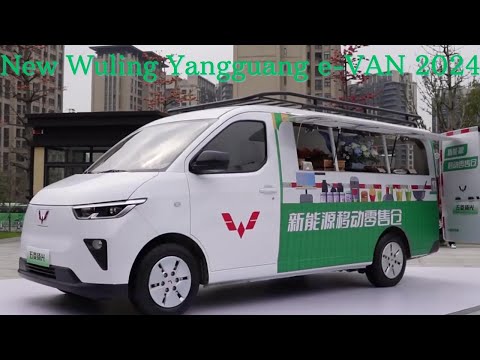Wuling Yangguang EV Video Review
Equipped with an electric motor boasting a power output of 82 kW, or approximately 110 horsepower, the Wuling Yangguang EV demonstrates commendable performance. It generates 220 Nm of torque and reaches a top speed of 90 km/h. The van operates on a rear-wheel drive (RWD) system and provides a smooth, responsive driving experience, essential for urban logistics and deliveries.
What is the Wuling Yangguang EV?
The Wuling Yangguang EV is a commercial-grade electric van engineered for city logistics—and it comes in hot at just $10,000 (€9,200 / £8,000). Built by SAIC-GM-Wuling and launched in 2024, it’s an urban workhorse with a 300 km (186 mile) range, 42 kWh lithium iron phosphate (LFP) battery, and a rock-solid 1.25-ton (1249 kg) payload. In short: it’s not here to look pretty. It’s here to move things—efficiently and affordably. And with competition like the Renault Kangoo Z.E. and Nissan e-NV200 priced three times higher, the Yangguang makes a loud case for going electric without going broke.
Electric Van With 300 km Range for Daily Logistics
The 42 kWh battery gives you a CLTC-tested 300 km (186 miles) of range, which translates to a full day’s worth of deliveries for most urban logistics outfits. The optional 31.9 kWh pack offers 230 km (143 miles) for even tighter budgets. Either way, you won’t be range-stressed if your delivery route doesn’t stretch beyond city borders. And topping off the battery isn’t a nightmare—DC fast charging gets you from 30% to 80% in about 30 minutes, while an AC Level 2 setup recharges overnight in about 7.5 hours. That’s perfect for a grab-and-go operation model.
1.25 Ton Payload and 6.5 m³ of Cargo Volume
With 1249 kg (2,753 lbs) of payload capacity and 6.5 cubic meters of cargo space, the Yangguang means business. The van measures 4985 mm long, 1800 mm wide, and 1975 mm high, with a 3050 mm wheelbase. That’s compact enough to handle narrow city streets but large enough to haul everything from boxes and tools to equipment or e-commerce loads. Rear barn doors and dual sliding side doors make cargo access effortless, and the flat floor lets you stack with confidence. For logistics professionals and small business owners, it checks every practical box—without blowing your budget.
Urban Performance Meets Simplicity
Powering the Yangguang is an 82 kW (110 hp) electric motor paired with 220 Nm of torque. It’s rear-wheel drive, which gives you better traction and stability when the cargo bay’s fully loaded. Top speed caps at 90 km/h (56 mph)—more than enough for city work, but don’t plan on cruising the Autobahn. Steering is electric-assisted, and the suspension is tuned for ride comfort under load. What you won’t hear is engine noise—just a quiet hum and the sound of your delivery route ticking off. It’s built for urban gridlock, roundabout-filled routes, and efficiency over ego.
Comparing the Yangguang EV to Other Electric Cargo Vans
Now let’s look at where it lands in the big picture. Compared to the Nissan e-NV200’s 200 km (124 miles) range and 705 kg (1554 lbs) payload, the Yangguang beats it handily. Same story for the Renault Kangoo Z.E. with 264 km (164 miles) of range and 650 kg (1433 lbs) payload. The Volkswagen e-Crafter offers a higher 1700 kg payload, but only 173 km (107 miles) range—and it’s in a different price universe at around $50,000. At just $10K, the Wuling Yangguang undercuts every major player and still delivers real-world usability and fast charging. It’s built for those who want the job done, not bells and whistles.
Interior and Driver Comfort: Just Enough to Get the Job Done
The cab is functional with just the essentials, but not unpleasant. You get two fabric-covered seats, a hard plastic partition between the cabin and cargo area, dual electric windows, manual air conditioning, and a 3.5-inch LCD cluster. Higher trims add an 8-inch touchscreen for infotainment and navigation, which is a welcome touch for route planning. No leather, no ambient lights—but you do get a USB port, reversing camera, and hill-start assist on certain versions. It’s not luxurious, but it’s comfy enough for long hours behind the wheel—and that’s what counts in commercial settings.
Running Costs and Sustainability Advantages
Electricity is cheap—really cheap. Wuling claims the van costs about 0.07 RMB per km to run, which converts to around $0.01. Over 100,000 km, that could save businesses up to $53,000 compared to gas-powered vans. Maintenance? Minimal. The LFP battery chemistry is incredibly durable, and there’s no oil, no spark plugs, no belts to worry about. With zero tailpipe emissions, the Yangguang slips into urban low-emission zones like a ghost, avoiding fees and bans. Whether you’re a bakery, delivery startup, or service contractor, it’ll save you money while making you look good to sustainability-minded clients.
Wuling’s Global Ambitions and What’s Next
Wuling isn’t new to the EV game. They’re the minds behind the wildly successful Hongguang Mini EV, and the Yangguang leverages that experience in a new segment. It’s already proving popular across China and is being positioned for rollouts in Southeast Asia and emerging markets like Indonesia and the Philippines. Right-hand drive variants are in the pipeline. As infrastructure improves and regulations tighten, Wuling is banking on practical EVs like the Yangguang to win the commercial crowd—and judging by this van’s value proposition, they’re onto something big.
Conclusion
Pros and Cons of the Wuling Yangguang EV
- Affordable price at $10,000 (€9,200 / £8,000)
- 300 km (186 mile) range with fast-charging support
- 1.25-ton payload and 6.5 m³ cargo volume
- Durable LFP battery and low running costs
- Compact size with excellent maneuverability
- Top speed limited to 90 km/h (56 mph)
- Interior is basic—no frills or high-end finishes
- No autonomous driving or advanced safety systems
- Limited availability outside China—for now
- No all-wheel-drive option
Final thoughts
If you’re looking for a no-nonsense electric van that’s tough, efficient, and incredibly wallet-friendly, the Wuling Yangguang EV is hard to ignore. It’s the workhorse EV built for the streets, not for show—and it’s priced to move.








